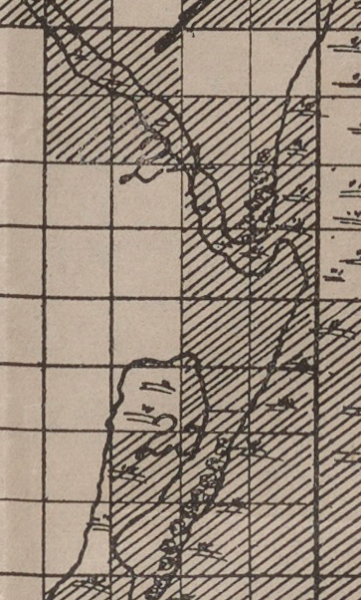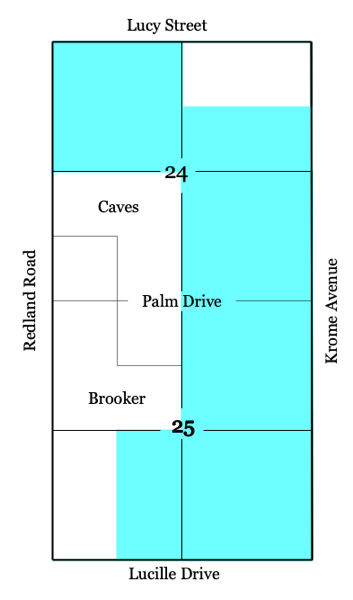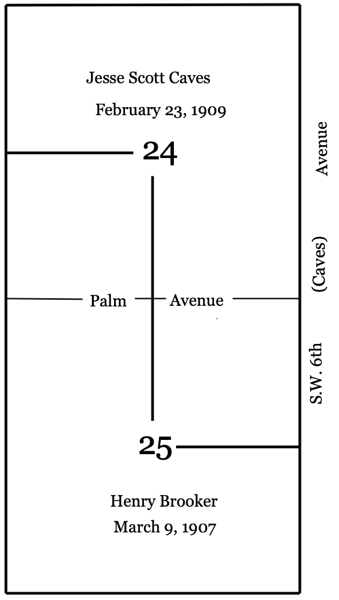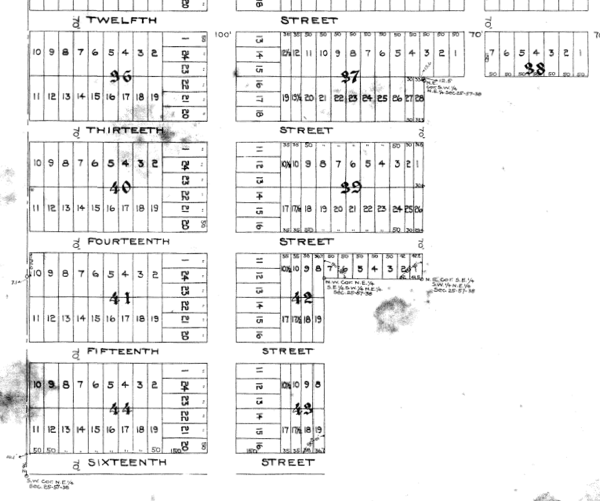Detroit Before Edward Stiling – Part II
In Part I of this article, I provided some of the history of the area that became Detroit before 1910. As can be seen on the relevant portion of the F.E.C. Railway map below, the Model Land Co. owned most of the land in sections 24 and 25 of township 57 south, range 38 east. Its holdings are shown with diagonal lines:

To make this clearer, here is a drawing that shows the holdings of the Model Land Co. in Detroit in light blue with the Brooker and Caves homestead claims in the west halves of sections 24 and 25 also shown:

Henry Brooker, who had been in Miami as early as May of 1905,1 was hired by the F.E.C. to help build the telegraph line from Miami to Key Vaca. That line was completed on October 26, 1907.2
Henry Brooker and Jesse Scott Caves filed for homestead claims in the west halves of the northwest quarter of section 25 and the southwest quarter of section 24 of Township 57 South, Range 38 East. The balance of sections 24 and 25 (see diagram above), with the exception of the land claimed by Horace K. Roberts (the north half of the northeast quarter of 24), was owned by the Model Land Co. and was purchased by the Tatum Bros. Real Estate and Development Co. in May of 1910.3

The drawing above shows Jesse S. Caves’ claim in the southwest quarter of 24-57-38 (top) and Henry Brooker’s claim in the northwest quarter of 25-57-38 (bottom).
The Model Land Co., following the scheme used in the federal township-range system, subdivided their lands into parcels which started at the northeast corner of each quarter-section and proceeded to the southeast corner of the section in 10-acre blocks instead of the 640 acre blocks used by the federal government:

Jean Taylor, in her book The Villages of South Dade, wrote that William H. Hunter purchased a ten-acre plot of land and built a house in 1908 “at what later became the corner of S.E. 5th Avenue and S.E. 5th St. in Florida City.” A close study of the abstract of title for the Hunter property shows that Taylor was incorrect. The Hunter property was just outside the eastern boundary of what would become the Town of Detroit in 1910. On the portion of the plat for the Town of Florida City below, the Hunter property was adjacent to Blocks 42 and 43. Portions of it are now part of the Gateway mobile home park. In 1931, Mary E. Scott, Hunter’s widow, sold a strip of land 70′ wide so that Avenue B (now SW 3rd Ave.) could be extended.4
The plat of the Town of Detroit was recorded on November 19, 1913, about 5 years after Mr. Hunter purchased his land from the Model Land Co.

Taylor wrote that Hunter’s grove on his 10-acre plot of land was a failure but that he “was successful in growing tomatoes on the railroad land.”5 Hunter grew truck crops on 5 acres of marl land east of the depot in Homestead in 1908-1909, along with A. T. Duval (15 acres), W. D. Horne (2 acres), T. A. Campbell (2 acres), Henry Brooker (10 acres), Leonard Mowry (10 acres) and Barney Waldin (5 acres).6
He also farmed “south of Homestead”7 during that season but the specific location was not noted. It is highly unlikely that Hunter either built a house, grew truck crops or planted a grove on that 10-acre parcel that early. It flooded in the summer and there was no way, short of flagging down a train, to get his crops to market and no easy way to get equipment and supplies to the land.
On June 9, 1909, Hunter’s daughter, Ida, was married to Thomas F. Cochran of Miami at her father’s home in Homestead.8
Homestead claims west of what was to become Detroit were filed as early as 1905 and by 1909, there were 10 claims on both sides of the future Palm Drive west of the Model Land Co. property that became Detroit.
In February of 1910, Henry Brooker and William Hunter filed a report with the Dade County Commission that laid out the route of a public road from Homestead to Detroit. It ran from the south end of Homestead Avenue, one block east of Railroad Avenue, crossed the railroad at an unstated point,9 and ran between the railroad and the Everglades across the Long Prairie, between Homestead and Detroit. When it reached the section line that is now Palm Drive, it ran west to the Camp Jackson Road near S.W. 197 Avenue.10 This rough road opened up the country for the existing homesteaders and made it accessible to a large number of new homesteaders who filed claims in 1910 and later.
On September 15, 1910, the Homestead correspondent for the Miami Morning News-Record reported that “Harry Hunter, eldest son of Mr. W. H. Hunter of Homestead and his bride, formerly Miss Clara Bates, daughter of T. J. Bates of Miami,” had gotten off the train in Homestead and “were bound for the home of the groom’s parents, where a bountiful dinner awaited them.”11 Shortly after this time, Hunter moved to his new house in the settlement of Detroit, for on November 15, 1910, he told a reporter for the Miami Metropolis that he lived there and stated that there were “over one hundred citizens there now … and that within a few months, three hundred will make their home there.”12
While Hunter was claiming credit for being the first resident and also stating that there were more people living there than the 30 pioneers that Edward Stiling had brought on October 28, 1910, another man, Joseph L. “Lafe” Ishmael, had actually built a house there. In a letter dated December 24, 1910 to his home-town newspaper in Arkansas City, Kansas, Ishmael wrote:
“We were the first family in Detroit. We came August 18. I began to build September 15. Now there are 200 people here. There are eighteen small houses and about twenty tents. There are two grocery stores, one is in a tent. A hotel is going up and there is a contract for a packing house 40 x 100. There is a sawmill on the town site. We have a nice little house two nice porches, 10 x 28. We hold church services and Sunday school on our front porch and will until there is a church built. We are raising money now to build one.”13
Since Lafe made a point of mentioning that his was the first family in Detroit, it appears that other later arrivals, including Hunter, were claiming to be first. Lafe’s contemporary letter, dated December 24, 1910, sought to disprove those claims.
Joseph L. “Lafe” Ishmael was born in October of 1856 in Montgomery County, Illinois. There, he married Nancy S. Ford in April of 1877 and started a family. By 1889, he had moved his family to Arkansas City, Kansas.14 Arkansas City was a commercial hub in southeastern Kansas, 60 miles south of Wichita and 100 miles north of Guthrie, Oklahoma. Lafe held a variety of jobs, apparently working for the Atchison, Topeka and Santa Fe Railroad in Guthrie, Oklahoma, briefly owning a grocery store in Arkansas City in 1890,15 being a policeman for Arkansas City for several years,16 being a janitor, the sexton of the City cemetery and then returning to being a grocer again in 1905, when he partnered with Tom Tyler to open a grocery store named Tyler & Ishmael.17 In March of 1906, he bought out his partner and continued to run the business by himself.18
Lafe divorced his first wife in the early 1900s and married his second wife, Mrs. Grace Yeakel Higgins, in Wichita on May 2, 1909.19 On May 21, 1910, he sold his grocery store in Arkansas City20 and on July 5, he and his new wife left for Detroit, Florida.21
A note in The Homestead Enterprise ten years later stated that “Mrs. Ishmael was the first white lady to come here in the original Detroit colony ten years ago.”22 By writing that Mrs. Ishmael was the “first white lady” in Detroit, the anonymous author for the newspaper was acknowledging that African-Americans lived there too.
By December of 1911, William Hunter was reported to be in poor health.23 He died on May 20, 1913 at his home in Miami.24 His widow, who had married James K. Scott, died in 1942 in Florida City but her son Herbert stayed there after marrying Lola Nixon, a niece of Lilburn R. Nixon. A son, Herbert Milton Hunter, was born to them in 1925. In the 1970s, he operated Milton’s Hair Salon in Homestead.
Lafe Ishmael worked for the Miami Land & Development Co. supervising the development of the drainage canal network in the East Glade and also as a carpenter who helped build Rev. Joseph A. Kahl’s house.25 He moved to Homestead before 1916, where his wife was a nurse and a friend of the Kromes.26 In June of 1918, the Ishmaels moved to Miami,27 where Lafe operated a grocery store.28 In later years, Lafe Ishmael ran a hotel in downtown Miami. He died in 1936 and is buried in Woodlawn Cemetery in Miami.
As is so common in history, those who stay get to tell the story. The Hunter family stayed in Florida City and Homestead and the Ishmaels moved to Miami, taking their story with them. For her entry on the Hunter family,29 Jean Taylor interviewed Ida Hunter Cochran Flowers and her mother, Lola Nixon Hunter. Their story did not include Lafe Ishmael, but he was the first resident of Detroit, not William Hunter.
_____________________________________________________________
- The Miami Evening Record, May 6, 1905, p. 4
- Taylor, The Villages of Homestead, p. 207; Gallagher, Florida’s Great Ocean Railway, p. 121
- The Miami Daily Metropolis, May 26, 1910, p. 7
- Taylor went on to write, on page 206, that “Henry Brooker was their first neighbor, and soon the settlers from Detroit arrived, and the town grew up around them.” That was not accurate, either – Henry Brooker claimed his homestead in 1907, before Hunter arrived, and his property was a good 1,000′ west of Hunter’s property. It also appears that Hunter squatted on the land, as it was owned by Henry H. Harrison and not sold to Mary E. Scott until 1915, after William had died. This information was extracted from an abstract of title for the W 1/2 of the SW 1/4 of the SE 1/4 of the NE 1/4 of 25-57-38 in the collections of the Historic Homestead Town Hall Museum.
- The Villages of South Dade, p. 206. This is more of Taylor’s confused writing. His 10-acre plot of land was not railroad land – it belonged to Henry H. Harrison, who purchased a parcel of land from the Model Land Co., which included the Hunter property, in September of 1908. The abstract of title for the W 1/2 of the SW 1/4 of the SE 1/4 of the NE 1/4 of 25-57-38, owned by the Historic Homestead Town Hall Museum, makes that clear.
- The Miami Metropolis, February 9, 1909, p. 6
- The Miami Metropolis, July 23, 1909, p. 8
- The Miami Metropolis, June 12, 1909, p. 8
- The unstated point was where Arthur Vining Davis Parkway crosses the busway
- The Miami Metropolis, February 10, 1910, p. 3
- The Miami Morning News-Record, September 16, 1910, p. 4
- The Miami Metropolis, November 15, 1910, p. 4
- The Arkansas Daily Traveler, Arkansas City, Kansas, December 29, 1910, p. 3
- Arkansas City Daily Traveler, February 13, 1889, p. 4
- Arkansas City Daily Traveler, March 2, 1890, p. 4
- The first mention of him as a policeman was in the Arkansas City Daily Traveler on February 25, 1895
- Arkansas City Daily Traveler, June 27, 1905, p. 5
- Arkansas City Daily Traveler, March 13, 1906, p. 2
- The Arkansas City Daily Traveler, Arkansas City, Kansas, Monday, May 3, 1909, p. 4
- The Arkansas City Daily Traveler, May 21, 1910, p. 1
- The Arkansas City Daily Traveler, Wednesday, June 29, 1910, p. 5
- The Homestead Enterprise, January 15, 1920, p. 3
- The Miami Metropolis, December 8, 1911, p. 4
- The Miami Herald, May 21, 1913, p. 8
- The South Florida Banner, July 25, 1913, p. 4 and August 15, 1913, p. 1
- The Homestead Enterprise, August 24, 1916, p. 2
- The Homestead Enterprise, June 6, 1918, p. 1
- Naturalization petition of Elmer A. Ennis, the father of Bruce A. Ennis of Homestead
- The Villages of South Dade, p. 206

“A son, Herbert Milton Hunter, was born to them in 1925. In the 1970s, he operated Milton’s Hair Salon in Homestead.” Do you know if this could have been the barber shop that was located on Krome Ave. next to the Seminole?
No, Milton’s was in the 300 block of N. Krome, across the street from the First Baptist Church.
I had never heard of Lafe Ishmael until this article. Good job!
Always interesting, Jeff.. Thanks for all your diligent work in ferreting out the details, twists and turns, sorting fact from fiction.
Good work Jeff. If you take a look at the 1910 census, the April 25 sheet, you will see Mamie Williams, Black, with two children ages 9 and 7. If you look at the group photo in front of one of three small dwellings at the Pioneer Museum, you will see two children. I couldn’t find a Black family with two children on the other census sheets. The three small dwellings are shown on the 1926 Sanborn map just north of Palm Drive, east of the busway.
On page 7-A of the 1910 census for Enumeration District 15, taken on April 25 by Theodore R. Kuntz, there are men, women and children labeled as Mulatto and Black from lines 19-31. The people listed on lines 15-18 are White and lived in the Modello area, as did Seaman Murden and his family, on lines 32-35. Of the 10 men listed, 5 were cutting timber, 3 were farmers and 2 were laborers. Three women were laundresses, 1 woman was unemployed and there were 2 children. They were not in Detroit.